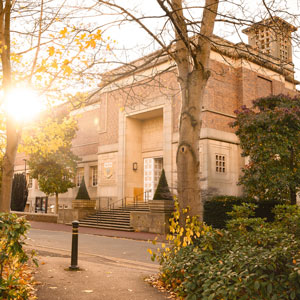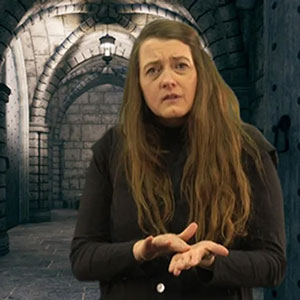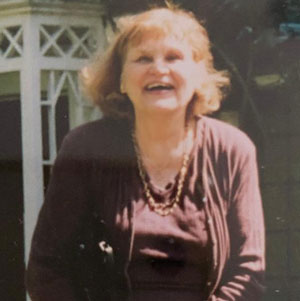From theatre to art galleries, Birmingham is working to make the arts accessible to everybody.
‘All the world’s a stage’ claimed Shakespeare, but many people face barriers in accessing art and culture. Those barriers can be physical, financial or simply that the activity hasn’t been designed with their needs in mind. Birmingham is helping address these challenges, so that these enriching experiences are open and available to all.
An art gallery for everyone
 Did you have famous paintings amongst the posters in your student halls? At Birmingham, students (and the whole community) can stroll across campus to the Barber Institute of Fine Arts to see art by the original painters. Founded by a philanthropic gift by Lady Barber in 1932, the Barber’s galleries are home to works by Botticelli, Magritte, Monet, Van Gogh and many more. The collection was always intended to be open to everyone but is not yet fully accessible by today’s standards for those with mobility issues or welcoming for schools and families as step-free access has only been available via a rear service yard, basement corridors and lifts.
Did you have famous paintings amongst the posters in your student halls? At Birmingham, students (and the whole community) can stroll across campus to the Barber Institute of Fine Arts to see art by the original painters. Founded by a philanthropic gift by Lady Barber in 1932, the Barber’s galleries are home to works by Botticelli, Magritte, Monet, Van Gogh and many more. The collection was always intended to be open to everyone but is not yet fully accessible by today’s standards for those with mobility issues or welcoming for schools and families as step-free access has only been available via a rear service yard, basement corridors and lifts.
The latest phase of major building improvements taking place from this spring, which must be carried out sensitively in the Grade-1 listed building, will:
- Bring music back to the Barber, through a new fresh-air ventilation system being retrofitted into the beautiful Art-Deco concert hall, enabling the much-loved Barber Concert series to return for the first time since the pandemic.
- Welcome visitors through a new public level-access entrance into the foyer and install a ground-floor inclusive and accessible lavatory with baby-changing facilities.
- Improve and enlarge the Barber’s reception, shop and refreshments area.
While these repairs are being carried out, the Barber is also hoping to upgrade its Learning and Engagement facilities and give its galleries a refresh – if funding can be found. Demand for the Barber’s sector-leading learning programme has outstripped current learning spaces as they cannot accommodate modern class-sizes of 30+ students.
The latest plans for the Barber will enable staff to welcome more school classes, families and groups for art and music activities, with a new learning wing in the ground-floor more than doubling the size of current learning facilities.
 The Barber team look forward to welcoming more visitors with mobility aids, prams or buggies, and other additional access needs, directly into the building’s reception space, making sure that everyone gets a warm welcome.
The Barber team look forward to welcoming more visitors with mobility aids, prams or buggies, and other additional access needs, directly into the building’s reception space, making sure that everyone gets a warm welcome.
Re-opening in 2026, the Barber will be a truly accessible hub for social and cultural life, just as Lady Barber intended.
Signing Shakespeare
Many people say they don’t really understand Shakespeare until they see it performed. Yet if you have to focus on a sign-language interpreter standing by the stage curtains, you can miss most of the action. Shakespeare is a compulsory part of the UK National Curriculum, but Deaf or hard of hearing pupils are not fully included in teaching, and on average, receive a lower grade than their hearing peers in exams at age 16.
The University’s Shakespeare Institute is making Shakespeare more accessible in schools, through teaching resources built around videos where the actors themselves use sign language, with workshops for teachers. Starting with Macbeth, the films reunite the character with their words, engaging deaf pupils more effectively with the plays and bringing them to life off the page.
 Deaf actor Sophine Stone said: ‘This isn't just a project for Deaf people, but a project which bridges the Deaf community and the Hearing, the linguistics of written and visual languages and the steady growth of inclusion within education… Shakespeare himself wrote about, and for, people of all backgrounds.’ See Sophie perform as Lady Macbeth by downloading the performance galleries.
Deaf actor Sophine Stone said: ‘This isn't just a project for Deaf people, but a project which bridges the Deaf community and the Hearing, the linguistics of written and visual languages and the steady growth of inclusion within education… Shakespeare himself wrote about, and for, people of all backgrounds.’ See Sophie perform as Lady Macbeth by downloading the performance galleries.
How graduate Joy Gibson is still sharing her love for Shakespeare
Following a successful career in fashion and arts journalism, Joy Gibson (MPhil (Art) Shakespeare Studies, 1994; MLitt Shakespeare Institute, 2006; PhD 2019) began studying at the Shakespeare Institute in the early 1990s and spent most of the rest of her life learning there. She published a book about the boy actors who played female roles, directed productions with the student drama society, the Shakespeare Institute Players, and on most Thursdays could be found at the seminars offered by world-renowned Institute faculty and eminent visiting speakers.
 Having become the only Institute research student to have completed a PhD in her nineties, Joy left a gift to the Shakespeare Institute in her will. Her gift will support the Institute’s own provision of Shakespearean education to students from many demographics, through targeted scholarships, and will help fund the Signing Shakespeare project to reach more schools. In Joy’s honour, the last Thursday seminar before Christmas is now known as the Joy Gibson seminar.
Having become the only Institute research student to have completed a PhD in her nineties, Joy left a gift to the Shakespeare Institute in her will. Her gift will support the Institute’s own provision of Shakespearean education to students from many demographics, through targeted scholarships, and will help fund the Signing Shakespeare project to reach more schools. In Joy’s honour, the last Thursday seminar before Christmas is now known as the Joy Gibson seminar.